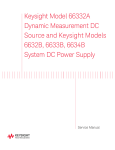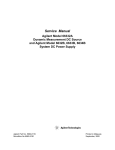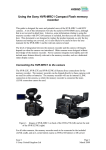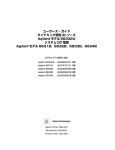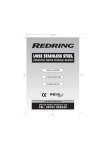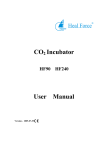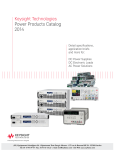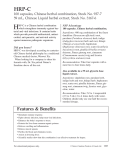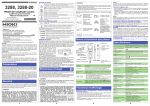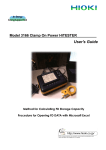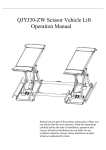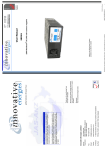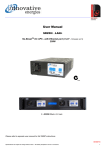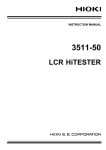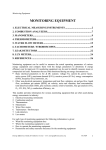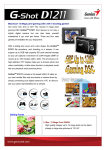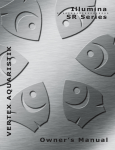Download Documentation No.
Transcript
LEUNG’S COMMUNICATIONS & ELECTRIC PRODUCTS (GUANGZHOU) LTD. Lithium-Ion Battery Pack Delivery Specifications Customer Name: TWS YF Product Model: BLUEJAY551235 Product Name: Rechargeable Lithium-Ion Battery Pack Cell Model: Lishen SP5530AB -180mAh Documentation No.: ENG-SPC-BLUE JAY-01 Rev: 05 Customer Approval TOTAL WIRELESS SOLUTIONS INDUSTRIAL LTD. Approved By Checked By Issued By Jiang.xinhua Zhou Wenwei Zhan Yi Yang Zhangyong 06.07.04 06.07.04 06.07.04 DCC-OP-0001-01—004A Rev.02 Documentation Name Product Specifications Product Model BLUE JAY Documentation No. ENG-SPC-BLUE JAY-01 Rev: 05 Date July 04, 2006 Page No. 1/14 History of Revisions No. Issue Date Content of Amendments 00 05.02.03 Preliminary Specifications 01 05.05.25 Modification of product and packaging outline 02 05.06.07 Modify 6.3, 6.4 and 8 03 05.06.09 Change the protect IC type for test 04 06.07.03 05 06.07.04 Modify 6.3,change R5426N110FA to R5402N110FC and ECH8601 to ECH8601R From Revision 02 Modify IC and MOSFET P/N and Related Excess Current Value From Revision 02, DCC-0P-0001-01—004A Rev 00 Documentation Name Product Specifications Product Model BLUE JAY Documentation No. ENG-SPC-BLUE JAY-01 Rev: 05 Date July 04, 2006 Page No. 2/14 Contents 1. Scope 2. Applicable Product Name 3. Composition 4. Product Performance 5. Performance and Test Conditions 6. Protection Function 7. Control Circuit 8. Product Outline and Part List 9. Charge State of Battery Pack before Shipment 10. Handling Precautions and Prohibitions on Lithium-Ion Rechargeable Battery 11. Precautions on Design of Set, Charger and Battery Pack 12. Warranty DCC-0P-0001-01—004A Rev 00 Documentation Name Product Specifications Product Model BLUE JAY Documentation No. ENG-SPC-BLUE JAY-01 Rev: 05 Date July 04, 2006 Page No. 3/14 1 Scope The scope of product specifications shall be applied to Lithium Ion Polymer rechargeable battery pack. 2 Applicable Product Name 2.1 Name: Rechargeable Lithium-Ion Polymer Battery Pack 2.2 Customer Product Number: BlueJay551235 3 Composition 3.1 Single cell: SP5530AB made by Lishen(Tianjin Lishen Battery J/S Co,Ltd) 4 Product Performance No. Item Rated 1 Rated Capacity 180mAh 2 Nominal Voltage 3.7V 3 Maximal Charge Voltage 4.20V 4 Discharge End Voltage 3.0V 5 Maximum Continuous Charge Current 180mA(1C) 6 Maximum Continuous Discharge Current 340mA(2C) 7 Operating Temperature Range 8 9 Remarks Mean operation voltage during rated discharge after rated charge. 0~45˚C Charge -20~60˚C Discharge -20~45˚C Within 1-month -20~35˚C Within 6-month Storage Temperature Range Weight 3.7±0.2g *1. Rated discharge; Constant current discharge (34mA) till discharge end Voltage (3.0V) at 25±5˚C *2. Rated charge; 4.2V constant voltage and 180mA current limited charge for 2.5 hours at 25±5˚C DCC-0P-0001-01—004A Rev 00 Documentation Name Product Specifications Product Model BLUE JAY Documentation No. ENG-SPC-BLUE JAY-01 Rev: 05 Date July 04, 2006 Page No. 4/14 5 Performance and Test Conditions 5.1 Test Conditions ♦ Tests shall be performed on a new battery pack within one week after delivery ♦ Unless otherwise defined, tests shall be performed at 25±5˚C (temperature), 65±20% (relative humidity) ♦ The measuring instruments are as follows: Voltmeter, Ammeter, Internal resistance meter, Caliper: Dynamic measurement DC Source 66332A (0~20V/0~5A) made by Agilent or Hewlett Packard, Digital Multimeter 34401A made by Agilent, AC Hitester 3560 made by HIOKI ♦ Percentage of a standard item is a capacity ratio to rated capacity 5.2 Performance No Item Standard Test condition 1 Outside Appearance No deformation or damage Visual check 2 Outside Dimensions As per attached drawing Caliper Equal or more than rates mentioned hereunder Measured time of discharge till end voltage at discharge conditions mentioned hereunder 3 Temperature Characteristics Discharge Temperature -10±2˚C 25±2˚C 60±2˚C Capacity ≥70% Capacity ≥100% Capacity ≥95% (0.5C discharge after rate charge at -10±2˚C) (0.5C discharge after rate charge at 25±2˚C) (0.5C discharge after rate charge at 60±2˚C) Measure at 25±5˚C 4 Internal Resistance Less than 250mΩ 5 Open Circuit Voltage ≥4.0 V 6 Cycle Life Cycle times ≥300 times Capacity ≥80% 7 Self-discharge Capacity ≥90% By alternate current (1kHz) within 1 hour after rated charge. Within 1hour after charge as measure open circuit voltage Discharge: 0.5C till 3.0V at 25±5ºC; the charge-discharge cycle shall be repeated 500 times and discharge capacity ≥80% of rated capacity At rated charge, leave for 30 days at 25±5ºC. Then discharge at 0.5 C till 3.0V, capacity ≥90% of rated capacity and measure the time of discharge DCC-0P-0001-01—004A Rev 00 Documentation Name Product Specifications Product Model BLUE JAY Documentation No. ENG-SPC-BLUE JAY-01 Rev: 05 Date July 04, 2006 Page No. 5/14 No Item 8 Standard No outside abnormality Temperature Humidity Cycle Discharge time ≥36mins Capacity ≥60% Test environment as below stated, at rated charge. Measured discharge capacity and the time of discharge and check outside appearance right at 40ºC, 90%RH, 48hrs Equal or more than rates mentioned hereunder At rated charge, leave for following condition. Then measured discharge capacity right after rated discharge/rated charge. a. 85% or more a. +20 ºC +/-5ºC: 28days b. 80% or more b. -20 ºC~+45ºC: 3months 9 Storage Performance Test condition -20 ºC~+60 ºC: 30days 10 Endurance to Drop No rupture or fire Discharge time ≥51min Discharge100% after rated charge, sample drop test on floor of 18~20mm hard wood from 1.0 height 2 times each for 3 surface. Then battery state is observed; and test the time of discharge at 1C discharge and charge-discharge cycle no more 3 times Vibrate test sample for 30 mins each, at room temperature after rated charge 11 Vibration Resistance No deformation, rupture or fire Voltage >3.6V Amplitude: 0.38mm(p-p) Frequency: 10-30Hz (sweep1Hz/min) Each axis (X,Y,Z) Then battery state is observed and measure voltage of the sample DCC-0P-0001-01—004A Rev 00 Documentation Name Product Specifications Product Model BLUE JAY Documentation No. ENG-SPC-BLUE JAY-01 Rev: 05 Date July 04, 2006 Page No. 6/14 5.3 Safety Performance at Unusual No Item Standard Test condition 1 Over Charge No rupture, fire, smoke, leakage or deformation At rated charge, leave for 8 hours as terminated to following condition; then check outside appearance. Over Discharge Protection circuit should operate and no deterioration of performance, nor outside abnormality At rated charge, discharge at 0.2C5A and leave for 24 hours with a 30Ω shorted terminals. Then check outside appearance No rupture or fire At rated charge, leave for 1 hour as shorted terminals with a 0.1Ω lectric wire. Then check outside appearance. Measure the voltage after instantaneous charge 5 seconds with 1 C5Acurent 2 3 Short between Terminals Voltage >3.6V after instantaneous charge 6 Protection Function 6.1 Cell ♦ Built-in safety valve (Prevent internal pressures build up) 6.2 Other protection devices ♦ Built-in protection circuit for overcharge, over discharge, over current and terminal short. 6.3 PCB Artwork Drawing DCC-0P-0001-01—004A Rev 00 Documentation Name Product Specifications Product Model BLUE JAY Documentation No. ENG-SPC-BLUE JAY-01 Rev: 05 Date July 04, 2006 Page No. 7/14 6.4 Battery Pack Circuitry DCC-0P-0001-01—004A Rev 00 Documentation Name Product Specifications Product Model BLUE JAY Documentation No. ENG-SPC-BLUE JAY-01 Rev: 05 Date July 04, 2006 Page No. 8/14 7 Control Circuit (Ta=25ºC) 7.1 Circuit Ratings No Item Specifications 1 Maximum Input Voltage 10V 2 Circuit Consumption Current (Shutdown condition) 2.5μA or less 3 Circuit Consumption Current (Normal condition) 10μA or less Remarks 7.2 Control Function No Function Item Min Standards Typ Max V 4.255 4.280 4.305 mS 170 250 325 Unit Remarks 1 Over Charge Detection Voltage 2 Output delay of Over-charge Cell voltage 3 Over Discharge Detection Voltage V 2.242 2.300 2.3588 Excess Discharge Current Threshold A 1.1 1.5 1.9 Excess Discharge Current Threshold Voltage mV 105 125 145 Output Delay of Excess Discharge Current mS 8 12 16 4 5 Overcharge is not detected, if cell voltage becomes lower than overcharge threshold voltage within output delay time of overcharge. Recovery conditions: remove charger and connect to load. With maximum of 6A, 16ms or less, over-current is detected and output shutdown. Excess discharge current is not detected, if discharge current become lower than excess discharge current threshold within output delay time of excess discharge current. Recovery conditions: remove load and connect to charger. 6 Excess Charge Current Threshold A 1.1 1.4 1.7 DCC-0P-0001-01—004A Rev 00 Documentation Name Product Specifications Product Model BLUE JAY Documentation No. ENG-SPC-BLUE JAY-01 Rev: 05 Date July 04, 2006 Page No. 9/14 8 Product Outline DCC-0P-0001-01—004A Rev 00 Documentation Name Product Specifications Product Model BLUE JAY Documentation No. ENG-SPC-BLUE JAY-01 Rev: 05 Date July 04, 2006 Page No. 10/14 9 Charge State of Battery Pack before Shipment 9.1 Charge state form: Approx. 30% charged 9.2 According to the Packaging Instruction DCC-0P-0001-01—004A Rev 00 Documentation Name Product Specifications Product Model BLUE JAY Documentation No. ENG-SPC-BLUE JAY-01 Rev: 05 Date July 04, 2006 Page No. 11/14 10 Handling Precautions and Prohibitions on Lithium-Ion Rechargeable Battery Inaccurate handling of lithium-Ion rechargeable battery may cause leakage, heat, smoke, an explosion, or fire. This could cause deterioration of performance or failure. Please be sure to follow instructions carefully. 10.1 Standard charge method ♦ Charging method is that 4.20V constant voltage and 85mA current limited charge (CC/CV) for 2.5hours. ♦ Battery voltage will be less than specified discharge end voltage for the long period storage. In that case, trickle charge less than 8.5mA till battery voltage reaches around 3.0V, and then start standard charging. But do not use battery if not recover during conditions above. Stop charging if the battery voltage is below 1V approx. 10.2 Storage ♦ Store the battery at low temperature (below 20˚C is recommended), low humidity, no dust and no corrosive gas atmosphere. 10.3 Handing precautions on Lithium ion Polymer Rechargeable Battery ! Danger ♦ When charging the battery, use dedicated chargers and following the specified condition. ♦ Use the battery only in the specified equipment. ♦ Don’t connect battery directly to an electric outlet or cigarette lighter charger. ♦ Don’t heat or throw battery into a fire. ♦ D on’t use, leave battery close to fire, inside of a car where temperature may be over 60˚C. Also don’t charge/discharge in such condition. ♦ Don’t immerse, throw, wet battery in water/seawater. ♦ Don’t short circuit the (+) and (-) terminals with other metals. ♦ Don’t place battery in a device with the (+) and (-) in the wrong way around. ♦ Don’t pierce battery with a sharp object such as a needle, etc. ♦ Don’t hit with a hammer, step on a throw or drop to cause strong shock. ♦ Don’t disassemble or modify the battery. ♦ Don’t solder a battery directly. ♦ Don’t use a battery with serious scar or deformation. ♦ Don’t use a battery in a corrosion environment (damage from salt water, seawater, acid, alkali, corrosion gas, etc.). DCC-0P-0001-01—004A Rev 00 Documentation Name Product Specifications Product Model BLUE JAY Documentation No. ENG-SPC-BLUE JAY-01 Rev: 05 Date July 04, 2006 Page No. 12/14 ! Warning ♦ Don’t put battery into a microwave oven, dryer, or high-pressure container. ♦ Don’t use battery with dry cells and other primary batteries, or batteries of a different package, type, or brand. ♦ Stop charging the battery if charging isn’t completed within the specified time. ♦ Stop using the battery if abnormal heat, order, discoloration, deformation, or abnormal condition is detected during use, charge, or storage. ♦ Keep away from fire immediately when leakage or foul odors are detected. ♦ If liquid leaks onto your skin or cloths, wash well with fresh water immediately. ♦ If liquid leaking from the battery gets into your eyes, don’t rub your eyes. Wash them well with clean water and go to see a doctor immediately. ! Caution ♦ Store batteries out of reach of children so that they are not accidentally swallowed ♦ If younger children use the battery, their guardians should explain the proper handling. ♦ Before using the battery, be sure to read the user’s manual and conditions on handling thoroughly. ♦ Thoroughly read the user’s manual for the charger before charging the battery. ♦ For information on installing and removing from equipment, thoroughly read user’s manual for the specific equipment. ♦ Batteries have life cycles. If the time that the battery powers equipment becomes much shorter than usual, the battery life is at an end. Replace the battery with a new same one. ♦ Remove a battery whose life cycle has expired from equipment immediately. ♦ When the battery is thrown away, be sure it is non-conducting by applying vinyl type to the (+) and (-)terminals. ♦ When not using battery for an expanded period, remove it from the equipment and store in a place with low humidity and low temperature. ♦ While the battery is charged, used and stored, keep it away from object or materials with static electric chargers. ♦ If the terminals of the battery become dirty, wipe with a dry cloth before using the battery. ♦ Please do not remove a label and the sheet to pull. 11 Precaution on Design of Set, Charger and Battery Pack. In order to make full use of the performance of lithium ion rechargeable battery, followings are recommended. 11.1 Battery Pack Installation Position in Set and Charger ♦ To prevent the deterioration of the battery performance by heat, battery shall be assembled away from the heat occurrence area of set and charger. DCC-0P-0001-01—004A Rev 00 Documentation Name Product Specifications Product Model BLUE JAY Documentation No. ENG-SPC-BLUE JAY-01 Rev: 05 Date July 04, 2006 Page No. 13/14 12 Warranty TWS can not take responsibility for the following problems. 12.1 Disassembling of the battery pack and cell. Never disassemble the battery pack and cell. If cell is disassembled, generated gas may irritate throats and the negative electrode plates may be heated and ignited. If battery pack disassembled is disassembled, safety protection circuit may cause breaking and may not operate safety system for charge and discharge. May cause heating, igniting and breaking of cell. 12.2 External short circuit of the battery pack Do not externally short-circuit the battery pack. If externally short-circuited, the battery pack may be heated, ignited or broken. 12.3 Throwing the battery into fire If battery pack is thrown into fire, it may be ignited or broken. 12.4 Throwing the battery into water If battery pack is thrown into water, safety protection circuit may cause breaking and may not operate safety system for charge and discharge. May cause heating, igniting and breaking. Oxygen and hydrogen may be generated by electrolysis of water, and the sealing part may be corroded and leaking may occur. 12.5 Soldering/heating of the battery pack Do not solder the terminal of the battery pack. Safety protection circuit may cause breaking and may not operate safety system for charge and discharge. May cause heating, igniting and breaking. If battery pack is heated over 100˚C, plastic parts may melt and cell may leak and may cause heating, igniting and breaking by internal short-circuited. 12.6 Incorrect inserting Do not insert battery pack +/- reversely. In some machines, battery pack may be short circuited externally, causing heat, ignition and breakage. 12.7 Mounting to units Do not mount in close structure. Combustibles released from cells in operating safety mechanism may ignite sparks generated by the motor, switches, etc. Take notice to immediately release combustibles from the units. 12.8 Over charge, inverse charge in high current Do not charge, over-charge or inverse-charge in higher current than specified. Gas may be quickly generated in the cell inside, causing ignition or breakage. Charging by chargers not specified or modified chargers being specified may cause heating, ignition and breaking. 12.9 Use in other usage Do not use battery pack to other units or in other usage. Specification difference may damage battery pack or break units. 12.10 Deformation If battery pack is deformed by applying pressure, etc., the sealing part of cell may be deformed, causing leakage, or internal short circuit may cause heating, ignition or breaking. DCC-0P-0001-01—004A Rev 00














